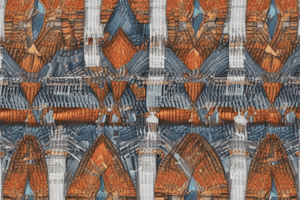Podcast
Questions and Answers
Plain weave is a type of weaving pattern where each weft yarn passes over one warp yarn and then under the next warp yarn, creating a simple criss-cross pattern.
Plain weave is a type of weaving pattern where each weft yarn passes over one warp yarn and then under the next warp yarn, creating a simple criss-cross pattern.
True (A)
Twill weave is a type of weaving pattern characterized by diagonal lines or ridges formed by the weft yarn passing over multiple warp yarns before changing direction.
Twill weave is a type of weaving pattern characterized by diagonal lines or ridges formed by the weft yarn passing over multiple warp yarns before changing direction.
True (A)
Damask and brocade are examples of basic weaves and are known for their intricate patterns created by varying the texture of the fabric.
Damask and brocade are examples of basic weaves and are known for their intricate patterns created by varying the texture of the fabric.
False (B)
Weaving techniques have no influence on the properties or behaviors of the final fabric structure.
Weaving techniques have no influence on the properties or behaviors of the final fabric structure.
Velvet is an example of a woven fabric that has a soft, plush texture due to the way the fibers are arranged using specialized weaving techniques.
Velvet is an example of a woven fabric that has a soft, plush texture due to the way the fibers are arranged using specialized weaving techniques.
Vertical looms hold the warps vertically and allow both vertical and horizontal orientations of strung yarns.
Vertical looms hold the warps vertically and allow both vertical and horizontal orientations of strung yarns.
Combination looms can only hold the warps in a vertical orientation.
Combination looms can only hold the warps in a vertical orientation.
Jacquard weaving and dobby weaving are modern industrial weaving methods that have led to improvements in speed, efficiency, and productivity.
Jacquard weaving and dobby weaving are modern industrial weaving methods that have led to improvements in speed, efficiency, and productivity.
All looms fall into one of the three primary categories: countermarches, compound frame, and laminate frames.
All looms fall into one of the three primary categories: countermarches, compound frame, and laminate frames.
Weaving involves creating textiles through either warps or fillings, but never through the interlaced patterning of both.
Weaving involves creating textiles through either warps or fillings, but never through the interlaced patterning of both.
Flashcards are hidden until you start studying
Study Notes
Weaving is a time-honored craft used to create fabric from threads by intersecting them at right angles. To understand this process further, let's explore some key aspects of weaving:
Interlacing Patterns
In weaving, the pattern is formed through the interplay of two sets of yarns—the warp (vertical) and the filling (horizontal). There are several common basic weaves such as plain weave, twill, taffeta, satin, variation of these weaves and blends of various weaves. These include damask, brocade, tapestry, velvet, rep, dralon, etc., which can also be combined with one another. Some specific examples of warp and filling combinations include check (plaid), herringbone, diagonal rib, twill stripe, basket weave, woven duck cloth, canvas, jean cloth, printcloth, worsted flannel, woolen flannel, melton, cashmere cloth, tweed, serge, crêpe de Chine, georgette, chiffon, tulle, gauze, organdy, Swiss voile, batiste, lawn, lawnette, gossamer, organza, broche, crepon, jaconet, fine nets, lace, printed fabrics like plains, checks, bar checks, lines, diamonds, stripes, thread, tape, loose binding, furnishing fabrics like cotton velveteens, wool felts, furs, knitted goods, raysons, raylon, cheesecloth, nonwovens, paperbacks, sackings, suiting materials, etc..
Weaving Techniques
The technique employed during the weaving process determines how the fibers are arranged within the fabric structure, leading to different properties, appearances, and behaviors. For instance, as you go up a level, more complex weaving structures result in finer fabrics with better drape qualities. Some weaving methods include handweaving, powerloom weaving, jacquard weaving, dobby weaving, warp knitting, weft knitting, felt making, tufting, and braiding. While traditional manual handweaving involves using a loom for all operations, modern industrial weaving machines employ a shuttle as well as automated dobbies, which has led to improvements in speed, efficiency, and productivity.
Types of Looms
Loosely speaking, there are three primary categories of looms based on the method they utilize to hold the warps: vertical looms, horizontal looms, and combination looms. Vertical looms have warps strung vertically and held stationary while working; horizontal looms work similarly, only horizontally; and combination looms allow both orientations of strung yarns. Furthermore, looms are categorized into four major classes based on their design principle: countermarches, compound frame, lamina frames, and linen looms. Each type of loom offers its own advantages when it comes to versatility, ease of handling, weight, and cost.
In summary, weaving involves creating intricate textiles via interlaced patterning achieved through fundamentals such as warps and fillings, whose variations lead to diverse fabric characteristics. The methods employed range from ancient handweaving techniques to contemporary high-speed machinery, reflecting the evolution of this fascinating art form.
Studying That Suits You
Use AI to generate personalized quizzes and flashcards to suit your learning preferences.




